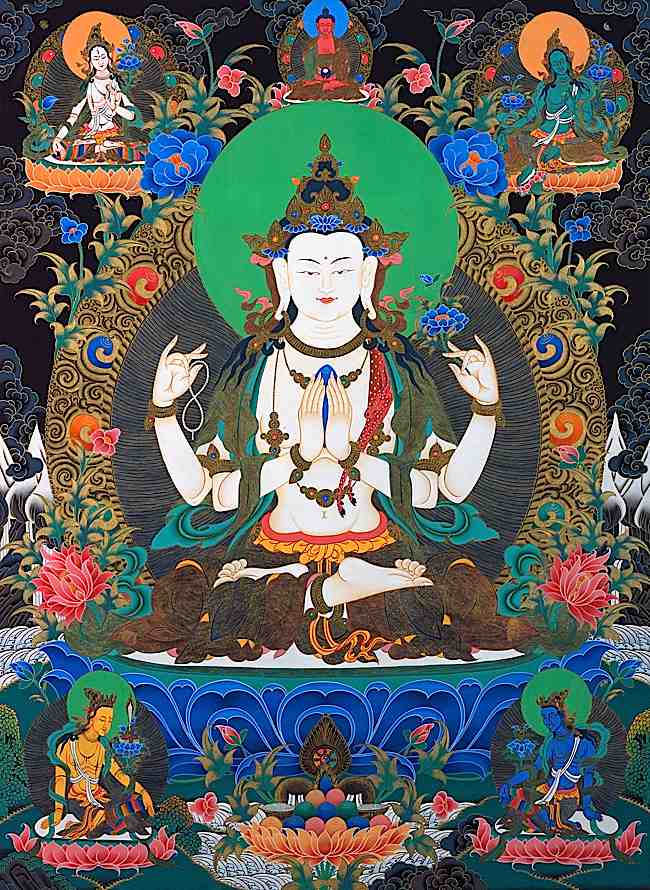
Meaning of Avaloketsvara's extensive Dharana
नमो रतनत्रयाय, नमो आर्य ज्ञाना, सागरा, वैरोचना, व्यूहाराजय, तथागताय, अर्हते ,सम्यक सम् बुद्धाया।। नमो सर्व ताथगतेभ्य, अरहतेभ्य, सम्यक सम् बोधिभ्य। नमो आर्य अवलोखितेश्वराय,बोधिसत्वाय, महासत्तवाय महाकरुणिकाय। तद्यथा, ॐ धरा,धरा, धीरी, धिरी, धुरू धुरु, इतिवित्वी, ज्वले ज्वले, प्राजवले, प्राजवले कुसुमे कुसुमः धरे, इरि मिरी, चित्रेछ्ते चरम अपनाय, स्वाहा।।
ན་མོ་རཏྣཏྲ་ཡཱ་ཡ།
ན་མཿ ཨཱརྱ་ཛྙཱ་ན་སཱ་ག་ར། བཻ་རོ་ཙ་ན། བྷུ་ཧ་རཱ་ཛཱ་ཡ། ཏ་ཐཱ་ག་ཏ་ཡ།
ཨརྷ་ཏེ་སམྱཀྶཾ་བུད་དྷ་ཡ། ན་མཿ སརྦ་ཏ་ཐཱ་ག་ཏེ་བྷྱཿ ཨརྷ་ཏེ་བྷྱཿ
སམྱཀྶཾ་བུདྡྷེ་བྷྱཿ ན་མཿ ཨཱརྱ་ཨ་ཝ་ལོ་ཀི་ཏེ་ཤྭ་ར་ཡ། བོ་དྷི་ས་ཏྭ་ཡ།
མ་ཧཱ་ས་ཏྭ་ཡ། མ་ཧཱ་ཀ་རུ་ཎི་ཀཱ་ཡ། ཏདྱ་ཐཱ། ཨོཾ་དྷ་ར་དྷ་ར། དྷི་རི་དྷི་རི།
དྷུ་རུ་དྷུ་རུ། ཨིཊྚེ་ཝིཊྚེ། ཙ་ལེ་ཙ་ལེ། པྲ་ཙ་ལེ་པྲ་ཙ་ལེ། ཀུ་སུ་མེ།
ཀུ་སུ་མ་ཝ་རེ། ཨི་ལི་མི་ལི་ཙི་ཏི་ཛྭ་ལ་མ་པ་ན་ཡེ
NAMO RATNA TRAYĀYA / NAMA ĀRYA JÑĀNA SĀGARA VAIROCANA VYŪHA RĀJĀYA / TATHĀGATĀYA / ARHATE / SAMYAKSAṂ BUDDHĀYA / NAMAḤ SARVA TATHĀGATEVYAḤ / ARHATEVYAḤ SAMYAKSAM BUDDHEVYAḤ / NAMA ĀRYA AVALOKITEŚVARĀYA / BODHISATVĀYA / MAHĀSATVĀYA / MAHĀKĀRUṆIKĀYA / TADYATHĀ / OṂ DHARA DHARA / DHIRI DHIRI / DHURU DHURU / IṬṬI VAṬṬI / JVALE JVALE / PRAJVALE PRAJVALE / KUSUME / KUSUMA / DHARE / ILI MILI / CHITRE CHITE JVALAM APANAYA / SVAHA
ན་མོ་རཏྣཏྲ་ཡཱ་ཡ། རིན་ཆེན་རྣམ་གསུམ་ལ་ཕྱག་འཚལ་ལོ།
Namo Ratna Trayāya (Homage to the Triple Gem, Buddha Dharma and Sangha)
ན་མཿ ཨརྱ་ཛྙཱ་ན་སཱ་ག་ར། ཕྱག་འཚལ་ལོ་འཕགས་པ་ཡེ་ཤེས་རྒྱ་མ
Namaḥ Ārya Jñāna Sāgara (Homage to the ocean of noble wisdom)
བཻ་རོ་ཙ་ན། ལུས་ཅན་རྣམ་པར་སྣང་མཛད།
Vairocana (With form of Buddha Vairocana, the Luminous One or the Enlightening)
བྱཱུ་ཧ་རཱ་ཛཱ་ཡ། བཀོད་པའི་རྒྱལ་པོ།
Vyūha Rājāya (the King of the Manifestations)
ཏ་ཐཱ་ག་ཏཱ་ཡ། དེ་བཞིན་གཤེགས་པ།
Tathāgatāya (the Tathagata, who has gone to blissful state)
ཨརྷ་ཏེ་སམྱཀྶཾ་བུདྡྷ་ཡ།
དགྲ་བཅོམ་པ་ཡང་དག་པར་རྫོགས་པའི་
Arhate Samyaksam Buddhāya (who has destroyed all illutions and the perfectly awakened one)
ན་མཿ སརྦ་ཏ་ཐ་ག་ཏེ་བྷྱ༔ ཐམས་ཅད་དེ་བཞིན་གཤེགས་པ་རྣམས་ལ་
Namo Sarwa Tathātebhyaḥ (Homage to all Tathāgatas)
ཨརྷ་ཏེ་བྷྱཿ དགྲ་བཅོམ་པ་རྣམས་ལ།
Arhate (To the Arhats)
སམྱཀྶཾ་བུདྡྷེ་བྷྱ༔ ཡང་དག་པར་རྫོགས་པ་སངས་རྒྱས་རྣམས
Samyaksam Buddhāya (the perfectly awakened one)
ན་མཿ ཨཱརྱ་ཨ་ཝ་ལོ་ཀེ་ཏེ་ཤྭ་རཱ་ཡ། འཕགས་པ་སྤྱན་རས་གཟིགས་དབང་ཕྱུག་
Namo Arya Avalokiteśvarāya (Homage to Noble Avalokitesvara)
བོ་དྷི་ས་ཏྭ་ཡ། བྱང་ཆུབ་སེམས་དཔའ།
Bodhisattvāya (the Bodhisattva)
མ་ཧཱ་སཏྭ་ཡ། སེམས་དཔའ་ཆེན་པོ་ལ།
Mahasattvāya (the Great Bodhisattva)
མ་ཧཱ་ཀཱ་རུ་ཎི་ཀཱ་ཡ། ཐུགས་རྗེ་ཆེན་པོ་དང་ལྡན་པ།
Mahakarunikāya (the Great Compassionate one)
ཏདྱ་ཐཱ། འདི་ལྟ་སྟེ།
Tadyathā. (Thus)
ཨོཾ་དྷ་ར་དྷ་ར། གཟུངས་སྔགས།
Ōṃ Dhara Dhara (Om Mental protection)
དྷི་རི་དྷི་རི། འཛིན་པ་འཛིན་པ།
Dhiri Dhiri (Protect us fermly and sustain us )
དྷུ་རུ་དྷུ་རུ། ཟུངས་ཤིག་ཟུངས་ཤིག།
Dhuru Dhuru (Oh Sustain us)
ཨི་ཊྚེ། ཝེ་ཊྚེ། དབང་ཞུ་བ།།
Iṭṭe vitte ( May we have the strength )
ཙ་ལེ་ཙ་ལེ། བསྐྱོད་ཅིག་བསྐྱོད་ཅིག །
Cale Cale ( Move forward, Move forward )
པྲ་ཙ་ལེ་པྲ་ཙ་ལེ། རབ་ཏུ་བསྐྱོད་པ་རབ་ཏུ་བསྐྱོད་པ།
Pracale Pracale ( Move forward further, Move further along the path)
ཀུ་སུ་མེ། ཀུ་སུ་མ་ཝ་རེ། མེ་ཏོག་འཛིན་པ། མེ་ཏོག་གི་མཆོད་པ་འཛིན་པ།
Kusumē, Kusumavare (who holds flower, Who holds flower-offering)
ཨི་ལི། ཐབས་ཤེས།
Ili (Compassion and wisdom)
མི་ལི། བླ་མ་མཆོད།
Milli (the Supreme bliss)
Edited by Geshe Gedun Tharchin




